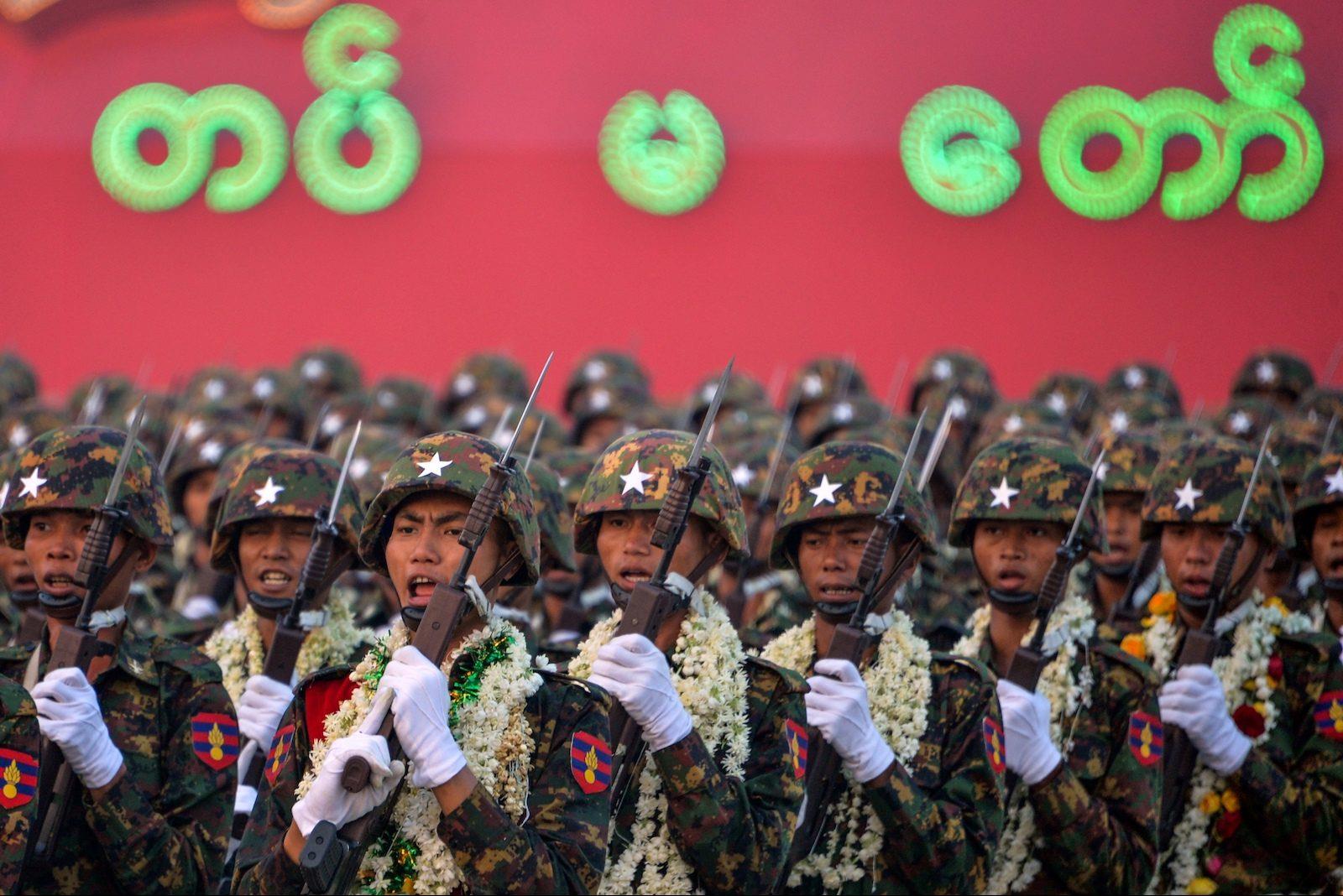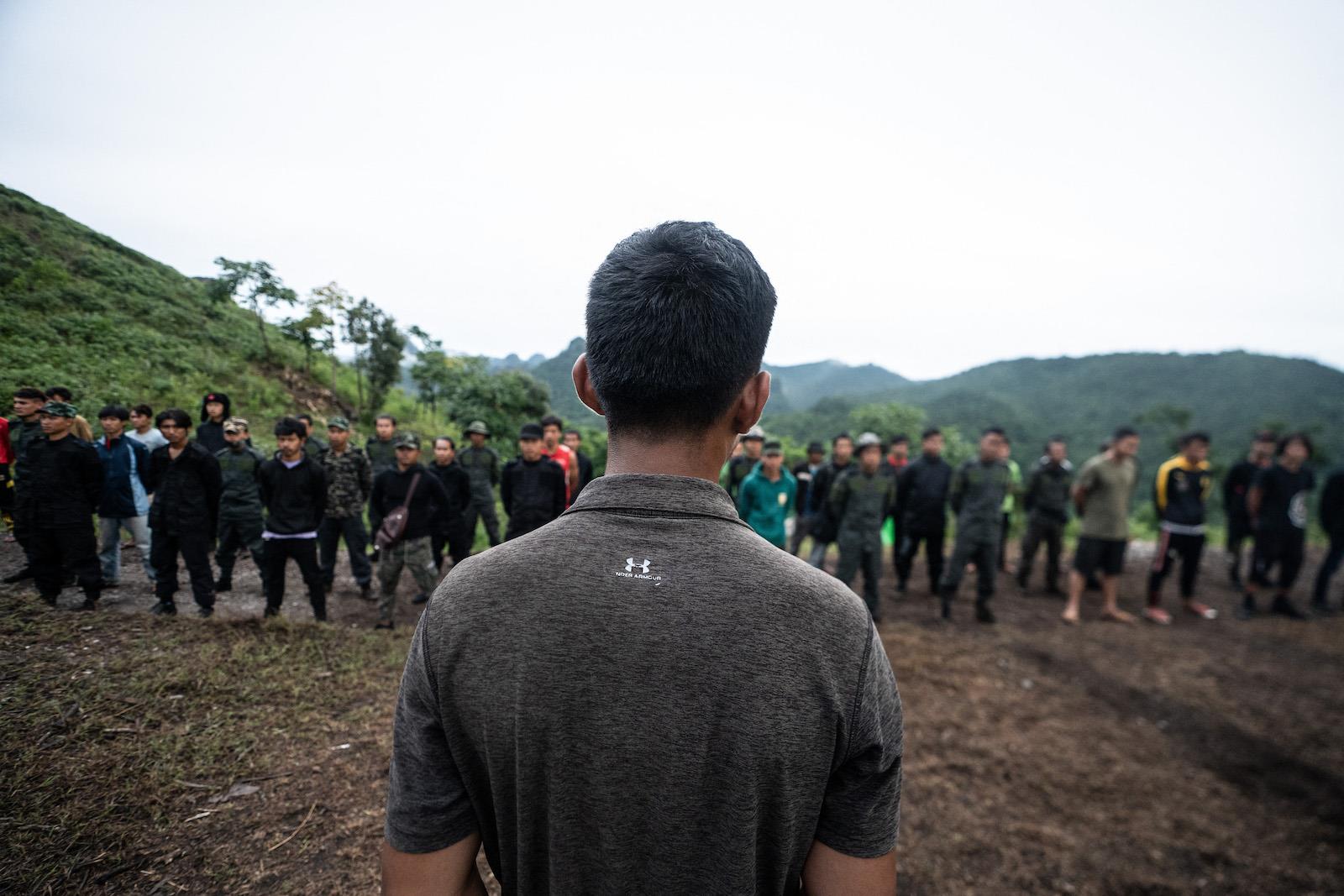Latest stories

Behind China's hack of UK's Electoral Commission

S Korean trade, diplomacy trending away from China

China challenges United States' EV subsidies at WTO Unfolding in a matter of weeks, the impact of this debacle on an army already facing a crisis of overstretched manpower has no doubt shaken confidence at command levels to the core and almost certainly triggered the early February decision to activate a national conscription law with a call-up process beginning in April.
The sheer volume of equipment and munitions lost in these serial defeats was no less threatening. In addition to huge quantities of small arms and light weapons, the army has lost scores of heavy 122mm and a few 155mm howitzers and at least 50 armored fighting vehicles. That's given the Brotherhood's ethnic armies conventional capabilities they have never wielded before.
Superimposing these human and material losses on a map of Myanmar reveals a politically and economically bankrupt regime encircled to the east, west, north and southeast by aggressively assertive ethnic opposition forces committed to its overthrow while at the same time facing relentless popular resistance across the military's traditional powerbase in the national heartland.
Military logic suggests that in broad strategic terms this correlation of forces can end only in the incumbent coup regime's defeat. The essential issue is how long this process may take and what cost it will exact.
Bloody struggle to come Expectations that recent advances in the borderlands have triggered a“tipping point” that can translate into a nationwide strategic offensive are almost certainly premature and need to be set against psychological and material factors that suggest the possibility, even likelihood, of a very bloody and long-drawn-out struggle across the central regions of the country.
In the first instance, it would be naive to overlook the peculiar psychoses of a ruling military caste that over seven decades of power, privilege and impunity has come to view itself not merely as the defender of the nation's sovereignty but also as the indispensable guardian of its soul.
The military elite's messianic obsession with national salvation and an ingrained xenophobia never far beneath the surface merge easily enough into a more down-to-earth fight for institutional and personal self-preservation.
Reinforcing these mindsets and doubtless appealing to some regime supporters is the narrative of a depleted and besieged Tatmadaw that in the early 1950s stood firm and ultimately prevailed against insurgent forces then ravaging the Bamar heartland.
For most army rank and file, however, instinctive discipline, a paycheck and the defense of family and comrades undoubtedly hold greater psychological sway than any misconstrued reading of history.

Myanmar's soldiers march in a formation during a parade to mark the country's 74th Armed Forces Day in Naypyidaw on March 27, 2019. Photo: Asia Times Files / AFP / Thet Aung At the material level, it is also important to appreciate that army losses suffered since October have been severe but hardly decisive.
According to one intelligence source's tentative assessment, the army still almost certainly numbers around 70,000 troops supported by militarized police and militia units organized under a unified command structure. A broader consensus among independent analysts supports this ballpark estimate.
Furthermore, at least some of these heartland forces constitute the praetorian core of military rule.
Typically marched out on annual March 27 Armed Forces Day parades, most are grouped under the Naypyidaw and Yangon Regional Military Commands (RMCs) and include special forces companies and airborne-trained battalions. Others are assault battalions drawn from centrally commanded – but now badly mauled – Light Infantry Divisions (LIDs) based around the heartland in key garrison cities such as Meiktila, Magwe, Pakokku and Bago.
Not unlike the Waffen SS of Nazi Germany, these loyalist units are composed of well-equipped, disciplined troops with a high esprit de corps and an undoubted readiness to escalate the fight with their backs now against the wall.
As fighting spreads across the central plains in the months ahead, these units will be supported by artillery and air power that events over the past year indicate will have no compunction in leveling entire urban communities where popular resistance forces operate or seek to take control. They may also be backed by armored units that to date have played virtually no role in the war.
Ranged on the other side of Myanmar's now starkly existential divide are newly formed Peoples Defense Forces (PDFs) that since mid-2021 have proved increasingly adept in guerrilla operations across wide swathes of central Myanmar, most notably in Sagaing but also in Mandalay, Magwe, Bago and southern Tanintharyi.
However, unlike the ethnic armies that since October have deployed trained and equipped battalions and brigades in carefully planned strategic offensives, PDFs in the Myanmar heartland fight as loose coalitions of lightly-armed guerrillas that for the most part have learned on the job.
Operating mostly without strategic direction and with tactical command-and-control that is often weak, these armed bands still lack the organization and equipment for sustained offensive operations against conventional forces maneuvering in strength. In short, if ethnic armies are ready for“strategic offensive” prime time, their PDF allies most certainly are not.
This stark disparity raises the prospect of a potentially protracted and savage war across the crowded heartlands of Myanmar with far heavier losses in resistance ranks than seen to date accompanied by levels of civilian displacement that could well dwarf an estimated 2.3 million already driven from their homes.
Chaos avoidance Two critical variables may serve to mitigate or perhaps even avoid a descent into open-ended, anomic chaos.
The most urgent relates to military capability and the extent to which key EROs are prepared to ramp up training and logistical support for heartland PDFs and in certain theaters possibly even commit their own manpower.
The framework for such cooperation already exists on various fronts where EROs, most notably Kachin, Karen and Ta'ang, have trained, equipped and mentored affiliated PDFs since the early days of armed resistance to the coup.
However, boosting the capabilities of PDFs over the coming months and into next year will require a far greater level of support resting on closer coordination between an ERO“coalition of the willing” and the NUG's Defense Ministry.
Specifically, it will demand a willingness to mobilize and equip regular PDF units with heavier weapons – particularly anti-aircraft heavy machine guns and mortars – drawn from the cornucopia of munitions captured over recent months.
Against the backdrop of a traditionally fraught relationship between ethnic minorities and the dominant Bamar, the political and financial impediments to such a strategic initiative are significant.
But“crunch time” for hard decisions focused on the future rather than the past has now arguably arrived.
China's role will also be important, if not critical. It remains unclear whether China will attempt to use its influence over the Brotherhood to limit large-scale support to PDFs under the NUG's command-and-control in the heartland; or alternatively, whether it has come to view the Brotherhood allies as valuable proxies in protecting its own interests in the Myanmar heartland and even more broadly in a post-SAC future.

Sign up for one of our free newsletters The Daily ReportStart your day right with Asia Times' top stories AT Weekly ReportA weekly roundup of Asia Times' most-read stories
A second variable hinges on PDF forces adopting a more unified military strategy. The dangers of uncoordinated lurches into a“strategic offensive” were amply demonstrated during the past dry season at Kawlin, a district center of no great strategic importance in Upper Sagaing captured by local PDFs supported by the KIA on November 6 at the heady height of 1027 euphoria.

This photo taken on July 7, 2021 shows members of the Karenni People Defense Force (KPDF) taking part in military training at their camp near Demoso in Kayah state. Photo: Asia Times Files / AFP / StringerHailed by the NUG as a model for liberated administration, Kawlin was then shelled, bombed, depopulated and finally retaken by the military in February, raising the obvious question of why in the absence of a broader plan it was seized in the first place.
More recently, in early March, the same opportunistic approach was adopted at Kani, a town on the Chindwin River also in Upper Sagaing where PDFs joined forces in a determined attempt to overrun the center only to have to withdraw under intense army pressure ten days later.
Both cases reflected the reality that while army garrisons are often isolated and weak, moving to seize towns at this stage of the war invites a concerted counterpunch that PDFs are unable to withstand. If these reverses could happen in Sagaing where PDFs have made hard-won battlefield progress, similar forays in Mandalay or Magwe regions would also certainly be repelled.
In place of uncoordinated and costly opportunism, a strategic approach offering far greater prospects for success would arguably focus not on population centers but on arteries of communication and resupply. Progressively asserting control along highways and restricting military movement between towns has two obvious benefits.
First, it draws army forces out of urban bases into exhausting road opening operations which over time become prohibitively costly. This dynamic is already visible on the Asia Highway to the Thai border at Myawaddy where the Karen and allied PDFs have essentially taken control of the road east of Kawkareik town.
Secondly, against a backdrop of constant guerrilla harassment that reaches into urban areas, a primary offensive focus on roads and railways provides time and space for building better-organized PDF units at battalion and brigade levels – forces that in the context of wider strategic planning will eventually be capable of taking and holding urban centers.
Neither the improvement of PDF capabilities nor the adoption of a strategic approach to operations in the heartland can or should be taken for granted. Indeed, the sheer weight of political and logistical challenges they impose on the NUG at the center of a dauntingly fragmented battlespace arguably militates against them.
The alternative to progress on both crucial fronts, however, may well be a descent into years of increasingly chaotic and costly violence with regional repercussions that are impossible to predict.
Already have an account?Sign in Sign up here to comment on Asia Times stories OR Thank you for registering!
An account was already registered with this email. Please check your inbox for an authentication link.